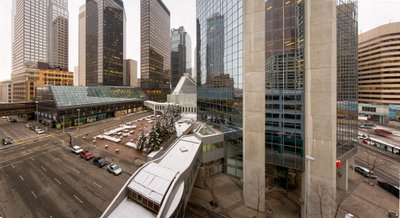

From my shoot at the parking garage this afternoon, the first image is the result of PTGui deciding that 4 images from a 17 mm. lens is too wide to stitch in a linear fashion - it is. What you see is a cylindrical perspective. This is the kind of view you used to get with Roundshot camera and other cameras which have a revolving mechanism. The net result is that everything that is the same distance from the camera is represented as the same size. You might think this is how an ordinary camera works, but not if you think about it.
In a normal camera, let's say that you photograph a group of 20 guys from a rugby team (not very tall, crooked noses, bashed ears, covered in bruises and grinning), in a line, facing the camera. Let's assume you are going to use a moderate wide angle, say a 35 mm. lens. (though it doesn't matter what focal length). With a modest wide angle lens, the middle person facing you is perhaps 12 feet away, but because they are in a straight line, the two fellows on the end are actually 18 feet from you. Since you are using flat film and a lens which focuses on a flat field, all members of the group are shown in a print as being in a straight line - thier heights are kept proportionate across the screen. The fellows on the end however appear to have gained a few pounds (they are slightly wider).
Were you to do the same exercise with a 17 mm. lens, you might have the middle fellow 6 feet away, and the end fellows 15 feet away, heights are still maintained and the end fellows have gained even more weight. This is simple optics. Were you to photograph a building from across the street and from half the height of the building, it would be recorded as rectangular.
In a cylindrical perspective image, the end fellows appear much smaller (after all they are further away). The lens makes no adjustments for perspective and the end fellows don't look fat. The building on the other hand becomes a very overweight rectangle, bulging out on top and bottom, but not sides (the camera is rotated horizontally, not vertically).
When you stitch, you actually rotate as if you were working with one of those rotating type cameras used to make 360 degree panoramas. When you rotate the camera to stitch, you aim the camera at the left end fellow, the middle fellow and then the right end fellow. Clearly the images will show the middle fellow as larger (since he's closer) and so the stitching software has to translate the images into linear perspective. It uses the knowledge of the angle of view of the lens (using exif info). The end result when using wide angles is the outside images are magnified in comparison to the middle image (to keep the rugby players the same height and to keep the rectangle from bulging outwards at top and bottom).
Note that in the top image, what appears to be two streets in the bottom corners is in fact one straight street, curving because the further parts of it show as smaller without linear perspective correction (remember the short rugby players). Note too though that the buildings aren't distorted, the cars not stretched by the nature of linear perspective (the rugby players don't look fat).
The last image below shows the result. The red areas show how the outer images are magnified. The non vertical sides reflect the adjustment PTGui made for the fact that the camera was aimed down slightly.
I continue to be very impressed with PTGui.




1 comment:
This was fascinating and so much more understandable because pictures were included. When you compared the two images, the concepts really started to gel. Thanks.
Post a Comment